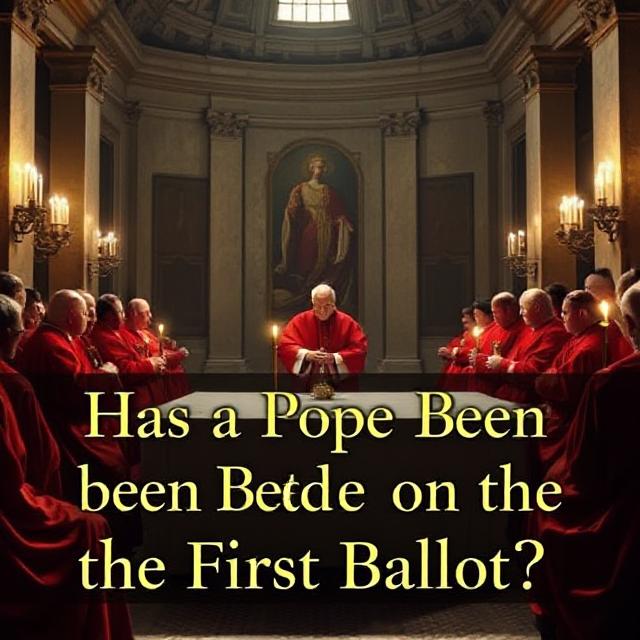The election of a new pope is one of the most secretive and sacred processes in the Catholic Church. Known as a papal conclave, this gathering of cardinals follows centuries-old traditions to select the next leader of over 1 billion Catholics worldwide. A common question surrounding these elections is: Has a pope ever been elected on the first ballot?
This article explores the history of papal elections, examines whether any pope was chosen in a single ballot, and explains how the voting process works.
Table of Contents
How Papal Elections Work: The Conclave Process
Before discussing first-ballot elections, it’s important to understand how popes are chosen:
- The Conclave Begins – After a pope dies or resigns, cardinals gather in the Sistine Chapel.
- Voting by Ballot – Cardinals write their choice on a ballot paper, which is then counted.
- Two-Thirds Majority Needed – A candidate must receive at least two-thirds of the votes to be elected.
- Multiple Rounds if Needed – If no one reaches the threshold, voting continues with up to four ballots per day.
- White Smoke Signals Success – When a pope is elected, burning ballots produce white smoke.
Since the 13th century, conclaves have followed strict rules to ensure a fair and prayerful election.
Has a Pope Ever Been Elected on the First Ballot?
Yes, several popes have been elected on the first ballot, though it is rare. Here are some notable examples:
1. Pope Pius XII (1939)
- Elected on the first ballot in one of the fastest conclaves in modern history.
- The election took just one day (March 2, 1939) with 62 cardinals voting.
2. Pope John Paul I (1978)
- Chosen on the first ballot after just one day of voting (August 26, 1978).
- His election was unusually quick, lasting only about 24 hours.
3. Pope Benedict XVI (2005)
- Elected on the fourth ballot, but some reports suggest he had near-unanimous support early on.
- While not strictly a first-ballot election, it was one of the fastest in recent times.
4. Pope Francis (2013)
- Elected on the fifth ballot, but his selection was relatively quick (two days).
- Some speculate he may have had strong first-ballot support.
Historical Cases (Pre-20th Century)
- Pope Julius II (1503) – Reportedly elected quickly due to strong backing.
- Pope Clement XIV (1769) – Chosen in a surprisingly fast conclave.
Why First-Ballot Elections Are Rare
Despite these examples, most conclaves take multiple ballots because:
- No Clear Favorite – Cardinals often need time to deliberate.
- Political Divisions – Historically, factions within the Church influenced elections.
- Prayerful Discernment – The process is meant to be thoughtful, not rushed.
- Secrecy and Negotiation – Some cardinals change votes after discussions.
The Fastest Papal Elections in History
| Pope | Year | Ballots | Duration |
|---|---|---|---|
| Pius XII | 1939 | 1st ballot | 1 day |
| John Paul I | 1978 | 1st ballot | 1 day |
| Benedict XVI | 2005 | 4th ballot | 2 days |
| Francis | 2013 | 5th ballot | 2 days |
| John Paul II | 1978 | 8th ballot | 2 days |
FAQs About Papal Elections
1. How many votes does it take to elect a pope?
- A two-thirds majority is required (currently 120 cardinals → 80+ votes needed).
2. What happens if no pope is elected?
- Voting continues with up to four ballots per day.
- After about 12-13 days, rules allow for a simple majority.
3. Can cardinals discuss votes between ballots?
- Yes, discussions happen during breaks in the Sistine Chapel.
4. Has a pope ever resigned after being elected quickly?
- Yes, Pope Celestine V (1294) resigned months after a quick election.
5. Do first-ballot popes have shorter reigns?
- Not necessarily—Pius XII served 19 years, while John Paul I died after 33 days.
Conclusion
While rare, several popes have been elected on the first ballot, including Pius XII and John Paul I. Most conclaves, however, require multiple rounds of voting as cardinals seek divine guidance and consensus. The speed of an election doesn’t necessarily predict a pope’s legacy—some of the most influential popes were chosen after lengthy deliberations.
The next time you see white smoke rising from the Vatican, remember that behind it lies a deeply spiritual and historical process that has shaped the Catholic Church for centuries.

